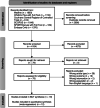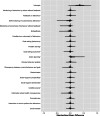Behaviour change techniques in cardiovascular disease smartphone apps to improve physical activity and sedentary behaviour: Systematic review and meta-regression
- PMID: 35799263
- PMCID: PMC9261070
- DOI: 10.1186/s12966-022-01319-8
Behaviour change techniques in cardiovascular disease smartphone apps to improve physical activity and sedentary behaviour: Systematic review and meta-regression
Abstract
Background: Smartphone apps are increasingly used to deliver physical activity and sedentary behaviour interventions for people with cardiovascular disease. However, the active components of these interventions which aim to change behaviours are unclear.
Aims: To identify behaviour change techniques used in smartphone app interventions for improving physical activity and sedentary behaviour in people with cardiovascular disease. Secondly, to investigate the association of the identified techniques on improving these behaviours.
Methods: Six databases (Medline, CINAHL Plus, Cochrane Library, SCOPUS, Sports Discus, EMBASE) were searched from 2007 to October 2020. Eligible studies used a smartphone app intervention for people with cardiovascular disease and reported a physical activity and/or sedentary behaviour outcome. The behaviour change techniques used within the apps for physical activity and/or sedentary behaviour were coded using the Behaviour Change Technique Taxonomy (v1). The association of behaviour change techniques on physical activity outcomes were explored through meta-regression.
Results: Forty behaviour change techniques were identified across the 19 included app-based interventions. Only two studies reported the behaviour change techniques used to target sedentary behaviour change. The most frequently used techniques for sedentary behaviour and physical activity were habit reversal and self-monitoring of behaviour respectively. In univariable analyses, action planning (β =0.42, 90%CrI 0.07-0.78) and graded tasks (β =0.33, 90%CrI -0.04-0.67) each had medium positive associations with increasing physical activity. Participants in interventions that used either self-monitoring outcome(s) of behaviour (i.e. outcomes other than physical activity) (β = - 0.47, 90%CrI -0.79--0.16), biofeedback (β = - 0.47, 90%CrI -0.81--0.15) and information about health consequences (β = - 0.42, 90%CrI -0.74--0.07) as behaviour change techniques, appeared to do less physical activity. In the multivariable model, these predictors were not clearly removed from zero.
Conclusion: The behaviour change techniques action planning and graded tasks are good candidates for causal testing in future experimental smartphone app designs.
Keywords: Action planning; Bayesian meta-analysis; Hypertension; Lifestyle modification; Stroke; mHealth.
© 2022. The Author(s).
Conflict of interest statement
The Authors declare that there is no conflict of interest.
Figures



Similar articles
-
Interventions for promoting habitual exercise in people living with and beyond cancer.Cochrane Database Syst Rev. 2018 Sep 19;9(9):CD010192. doi: 10.1002/14651858.CD010192.pub3. Cochrane Database Syst Rev. 2018. PMID: 30229557 Free PMC article.
-
Efficacy of interventions that use apps to improve diet, physical activity and sedentary behaviour: a systematic review.Int J Behav Nutr Phys Act. 2016 Dec 7;13(1):127. doi: 10.1186/s12966-016-0454-y. Int J Behav Nutr Phys Act. 2016. PMID: 27927218 Free PMC article.
-
Assessing the Acceptability and Effectiveness of Mobile-Based Physical Activity Interventions for Midlife Women During Menopause: Systematic Review of the Literature.JMIR Mhealth Uhealth. 2022 Dec 9;10(12):e40271. doi: 10.2196/40271. JMIR Mhealth Uhealth. 2022. PMID: 36485026 Free PMC article.
-
The Implementation of Behavior Change Techniques in mHealth Apps for Sleep: Systematic Review.JMIR Mhealth Uhealth. 2022 Apr 4;10(4):e33527. doi: 10.2196/33527. JMIR Mhealth Uhealth. 2022. PMID: 35377327 Free PMC article.
-
Systematic review of behaviour change techniques to promote participation in physical activity among people with dementia.Br J Health Psychol. 2018 Feb;23(1):148-170. doi: 10.1111/bjhp.12279. Epub 2017 Oct 4. Br J Health Psychol. 2018. PMID: 28980370
Cited by
-
Use of behavior change techniques in physical activity programs and services for older adults: findings from a rapid review.Ann Behav Med. 2024 Feb 10;58(3):216-226. doi: 10.1093/abm/kaad074. Ann Behav Med. 2024. PMID: 38300788 Free PMC article. Review.
-
Feasibility study of rehabilitation for cardiac patients aided by an artificial intelligence web-based programme: a randomised controlled trial (RECAP trial)-a study protocol.BMJ Open. 2024 Apr 30;14(4):e079404. doi: 10.1136/bmjopen-2023-079404. BMJ Open. 2024. PMID: 38688664 Free PMC article.
-
Use of Behavior Change Techniques in Digital HIV Prevention Programs for Adolescents and Young People: Systematic Review.JMIR Public Health Surveill. 2025 Apr 28;11:e59519. doi: 10.2196/59519. JMIR Public Health Surveill. 2025. PMID: 40293783 Free PMC article.
-
The Importance of Activating Factors in Physical Activity Interventions for Older Adults Using Information and Communication Technologies: Systematic Review.JMIR Mhealth Uhealth. 2023 Oct 24;11:e42968. doi: 10.2196/42968. JMIR Mhealth Uhealth. 2023. PMID: 37933182 Free PMC article.
-
Effective Behavior Change Techniques in Digital Health Interventions for the Prevention or Management of Noncommunicable Diseases: An Umbrella Review.Ann Behav Med. 2023 Sep 13;57(10):817-835. doi: 10.1093/abm/kaad041. Ann Behav Med. 2023. PMID: 37625030 Free PMC article.
References
-
- Akinosun AS, Polson R, Diaz-Skeete Y, De Kock JH, Carragher L, Leslie S, Grindle M, Gorely T. Digital technology interventions for risk factor modification in patients with cardiovascular disease: Systematic review and meta-analysis. JMIR mHealth uHealth. 2021;9(3):e21061. doi: 10.2196/21061. - DOI - PMC - PubMed
-
- Davis AJ, Parker HM, Gallagher R. Gamified applications for secondary prevention in patients with high cardiovascular disease risk: A systematic review of effectiveness and acceptability. J Clin Nursing. 2021. - PubMed
-
- Virani SS, Alonso A, Benjamin EJ, Bittencourt MS, Callaway CW, Carson AP, Chamberlain AM, Chang AR, Cheng S, Delling FN. Heart disease and stroke statistics—2020 update: a report from the American Heart Association. Circulation. 2020;141(9):e139–e596. doi: 10.1161/CIR.0000000000000757. - DOI - PubMed
Publication types
MeSH terms
LinkOut - more resources
Full Text Sources

